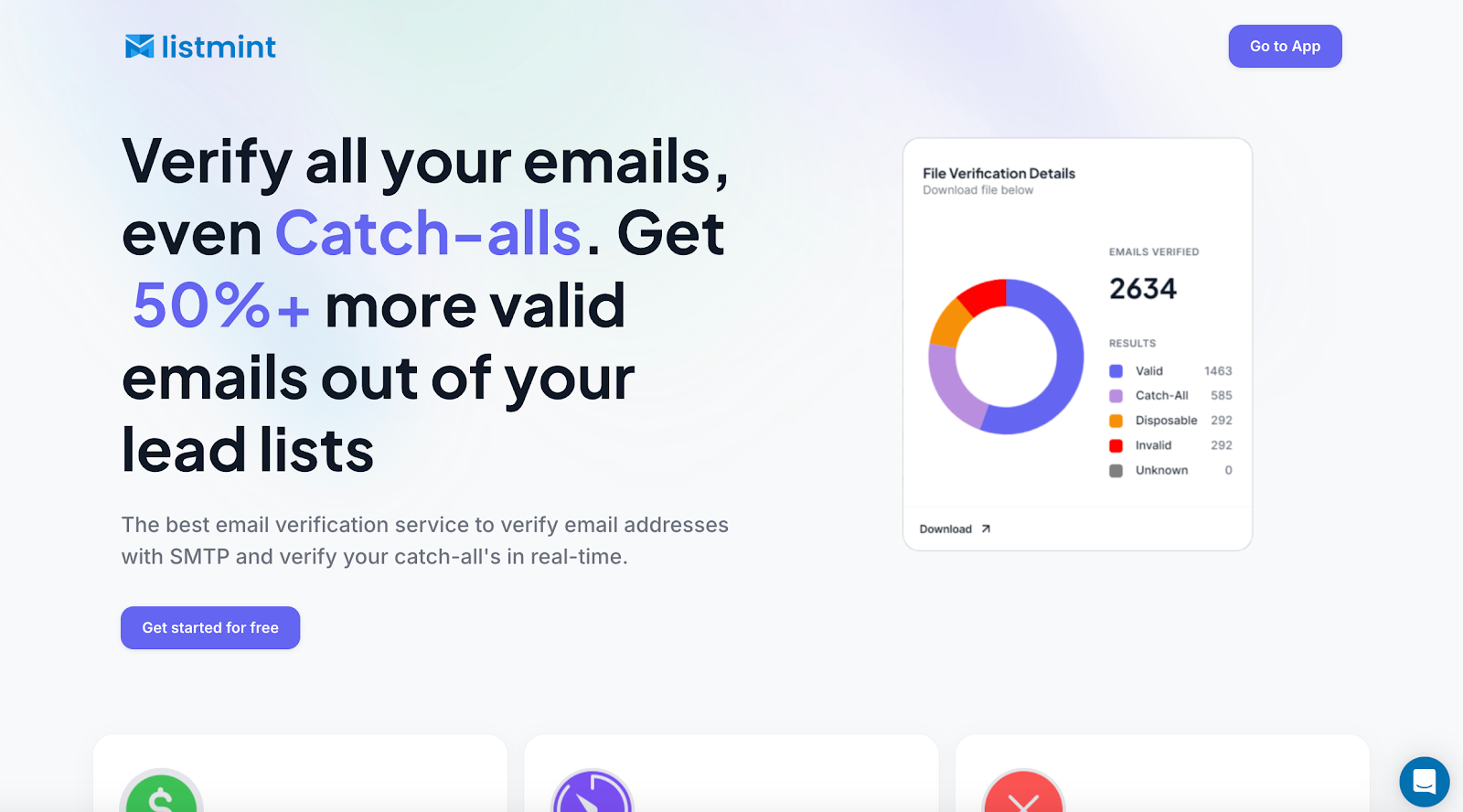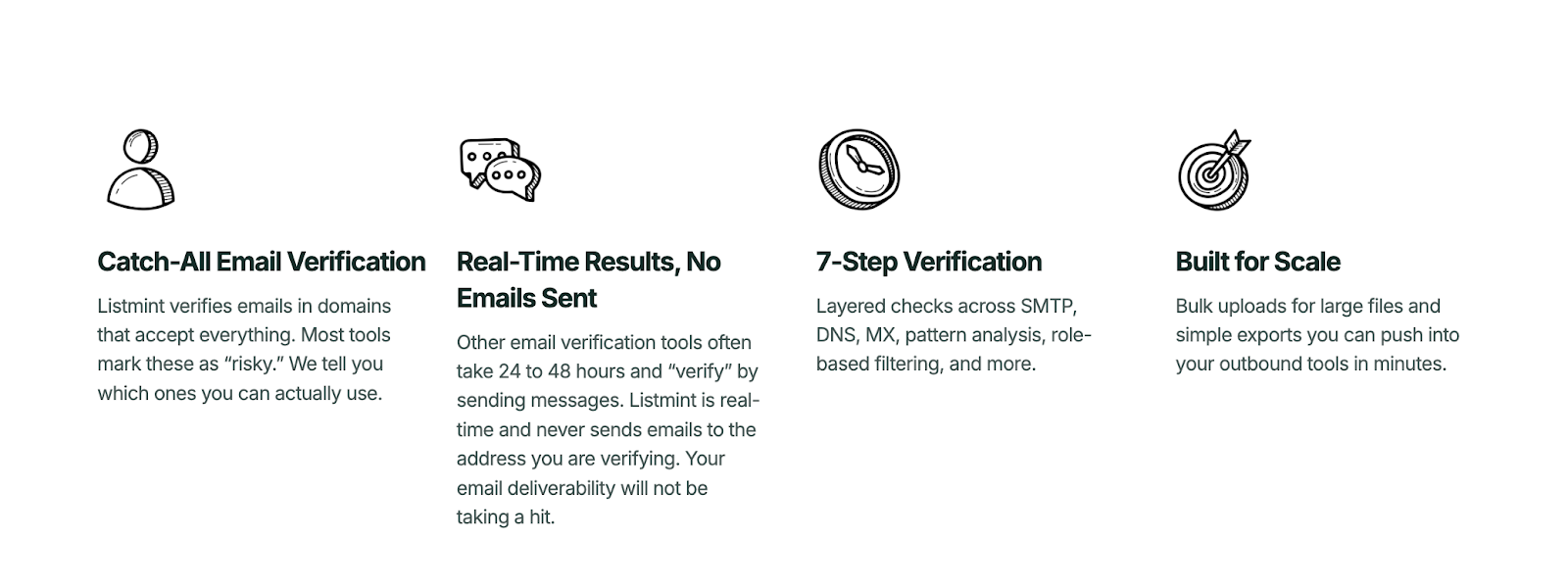
Lead verification makes the difference between working with reliable contacts and wasting resources on invalid ones.
When businesses depend on unverified leads, they face higher bounce rates, inaccurate data, and wasted time that could have gone toward connecting with real potential customers.
Every lead that enters a database should be checked for accuracy before it becomes part of sales and marketing efforts. Without that step, campaigns reach fewer people, sales teams lose focus, and reports reflect numbers that do not match reality.
In this blog, you’ll see how lead verification protects campaigns, improves data quality, and gives sales and marketing teams the confidence to focus only on real opportunities.
Lead verification is the process of checking whether a lead’s information is accurate, valid, and ready to use. It helps identify fake records, temporary email addresses, or other invalid prospects before they slip into a database.
A verified lead ensures sales and marketing teams spend their time on contacts that can actually respond.
Lead verification is often confused with lead validation, but there is a difference. Verification confirms that contact details, such as email addresses and phone numbers, exist and can be reached.
Validation goes further, checking if those details match specific criteria, such as demographic data or business operations, to confirm the lead is worth pursuing. Both play a role in keeping lead data accurate and up to date.
Skipping the lead verification process creates costly problems. Fake or unqualified leads drain valuable resources, inflate metrics, and reduce overall quality in sales and marketing efforts.
On the other hand, important lead verification steps help:
Strong lead verification ensures that lead generation efforts produce valid leads that match business needs. With data accuracy in place, sales and marketing teams can prioritize leads confidently and turn potential customers into paying customers.
Different types of lead verification exist to cover email addresses, phone numbers, and even engagement patterns. Here are the main categories to know:
Email verification checks if email addresses are valid and safe to use. It reviews syntax, domain records, and spam traps to confirm accuracy. Advanced checks also include catch-all verification, which helps recover contacts in domains that accept every message.
Tools like Listmint specialize in real-time verification, covering invalid leads, temporary email addresses, and other invalid prospects that lower data quality.
Using a dedicated lead verification software for email helps protect sender reputation and keeps marketing efforts focused on quality leads.
Verify your leads in real time. Get started with Listmint for free!
Phone verification confirms that a phone number belongs to a real person and can accept calls or text messages. It filters out fake phone numbers and temporary addresses that reduce lead quality.
Platforms like Twilio provide verification services through SMS or call-based checks, helping sales teams focus on valid leads instead of unqualified prospects.
Data validation goes beyond contact details. It cross-checks leads information such as names, company records, and demographic data against existing data sources. This step improves lead accuracy and helps prioritize leads that meet business needs.
CRMs like Salesforce or enrichment tools like Clearbit assist in validating lead data, supporting lead management, and better lead routing within sales and marketing teams.
Activity-based checks focus on how leads interact with campaigns and website forms. Valid leads usually engage with content, respond, or provide correct format details in lead capture forms. Unqualified or fraudulent leads often remain inactive.
Marketing automation tools such as HubSpot track engagement levels, making it easier to identify quality leads, protect valuable resources, and support sustainable growth in lead generation efforts.
A strong lead verification process keeps invalid leads out of your database and gives sales and marketing teams clean data they can trust.
Each step plays a role in protecting data quality and improving the overall quality of campaigns.
Leads often enter through website forms, paid ads, or event sign-ups. Collecting accurate lead information at the start lowers the risk of bad leads entering your system.
Using clear lead capture forms helps filter out fake records and keeps your lead generation efforts focused on potential customers.
Once a lead enters, the verification process begins with quick checks. Syntax validation confirms that email addresses follow the correct format, while domain and MX record lookups confirm if the address can accept mail.
Spam traps, duplicates, and temporary email addresses are also identified early, preventing wasted time and resources.
Real-time verification adds another layer of protection. Email verification tools check addresses instantly, while phone verification software confirms if numbers are active and linked to real people.
This step guarantees that only valid leads are passed on to sales and marketing teams. It gives them confidence in their outreach.
Not all leads are equal. Some records may pass basic checks but still lack the accuracy of the data needed for follow-up. Scoring helps identify unqualified leads, fraudulent leads, or other invalid prospects.
Risky contacts can be flagged for review, removed, or sent into separate workflows where sales teams do not waste valuable resources.
Verified leads are only useful when they move into action. Feeding valid lead data into CRMs, marketing platforms, or lead management systems so that sales and marketing efforts are built on accurate, up-to-date information.
This step supports better lead routing, keeps existing data clean, and helps sales teams prioritize leads that are more likely to become paying customers.
Many verification platforms stop at standard checks, leaving 30–40% of leads marked as risky or unknown.

Listmint goes further with real-time verification that confirms even catch-all addresses, turning risky records into usable data. With over 1 billion emails verified and accuracy rates above 99%, the platform gives sales and marketing teams the confidence to work only with quality leads.
For agencies and businesses running large campaigns, wasted time on invalid leads is costly. Listmint helps recover up to 84% of catch-all email addresses as valid, which means more potential customers to reach without inflating bounce rates.

Instead of waiting 48 hours for results like traditional verification APIs, users get instant answers that fit directly into their lead verification process.
Listmint is built to serve both direct users and companies that want to integrate verification into their own systems. The real-time API makes it possible to check leads as they enter through website forms or lead sources.
That level of speed and accuracy supports sustainable growth for sales teams, agencies, and marketing efforts that depend on clean data.
Listmint turns unverified leads into valuable resources, helping sales and marketing teams focus on quality leads that match business needs. With industry-leading accuracy, the platform reduces wasted time and protects sender reputation at scale.

Lead verification protects the effort behind every campaign by keeping data accurate and actionable. Without it, businesses risk wasted time, unreliable reporting, and weaker connections with potential customers.
Making verification part of daily sales and marketing processes helps guarantee that every lead entering the system has real value.
Listmint makes this simple. With real-time verification, advanced catch-all checks, and unmatched accuracy, it gives teams the confidence to work with leads that can actually convert.
For agencies, sales teams, and marketers alike, the platform turns unverified data into reliable opportunities.
Get started for free today and see how Listmint helps you connect with more valid leads.
A verified lead is a contact that has passed the lead validation process to confirm accuracy and reliability. It means the lead’s email, phone number, and other details are correct and can be used for outreach without risking bounces or wasted resources.
Leads can be verified in just a few clicks using lead verification software. The process checks details collected in a lead form, runs them through email or phone validation, and confirms if they meet industry standards for data quality.
A lead verifier confirms that lead information is accurate, up to date, and safe to use. This protects marketing teams, sales reps, and lead buyers by filtering out fake contacts and keeping efforts focused on the right target audience.
A reliable verification process saves time, prevents wasted spend, and improves the chances of turning valid leads into paying customers.
Lead verification improves conversion rates by removing invalid contacts and keeping sales teams focused on high-quality leads. Clean lead data supports accurate targeting, stronger outreach, and better alignment with the right audience.
The final thoughts highlight that without verified leads, conversion rates will always fall short of potential.
Verify all your emails, even Catch-alls in real-time with our Email Verification Software.
Create an account for free.